On May 7, 1901 at a small home in Helena, Montana, a prominent lawyer named Charles and his wife Alice gave birth to a son by the name of Frank James Cooper. Little did they know that their son Frank would grow to become one of the finest actors to grace the screen and would chart his course in history as one of Hollywood’s most dapper and stylish leading men.
The Early Years
His parents, both English immigrants, were devoted parents, with Alice as a stay-at-home mom and Charles working to keep the family comfortable. In 1906, Charles decided to purchase a 600-acre working cattle ranch known as Seven-Bar-Nine where Frank and his elder brother Arthur would spend their days learning to hunt, fish and ride horses.
Due to their British heritage, both Alice and Charles wanted their children to receive a proper English education, so in the summer of 1909, Alice accompanied the boys to England where they were enrolled at the prestigious Dunstable Grammar School in Bedfordshire. Cooper was quite the scholar and studied there from 1910 to 1912, studying Latin and French as well as English history. Despite being an American, Cooper managed to successfully adapt to the rigid discipline of the English school systems learning proper etiquette and social graces. After his successful completion of his confirmation classes in 1911, Cooper was baptized into the Anglican Church on December 3rd of that year. As summer came around in 1912, the boys were escorted by Alice back to the United States and Cooper resumed his education attending Johnson Grammar School in their hometown of Helena.
One of Cooper’s trademarks was his rather stiff and off-balanced strut, something that was caused by a car accident that left him with an injured hip. At his physicians request, he returned to his family’s ranch under the belief that horseback riding would help to cure his ailments.
Despite being a rather good student and enjoying his studies, Cooper abandoned his studies and left school in 1918 to help his family raise cattle on their ranch. He spent the next year working full-time as a cowboy before his father arranged for him to go back to school and resume his education in late 1919. Rather than returning to Helena for his studies, Cooper attended the Gallatin County High School in Bozeman, Montana where an English teacher named Ida Davis encouraged him to become involved in the dramatic arts. Forever indebted to her, Cooper once commented that “she was the woman partly responsible for me giving up cowboy-ing and going to college.”

Gary Cooper in a wool jacket and printed silk scarf 
Gary Cooper wearing a herring bone suit and grey v-neck sweater and bow tie 
Gary Cooper and a dog wearing a cardigan and white button down shirt and tie
By Spring of 1920, Cooper was still a high school student, yet took three elective art courses at the nearby Montana Agricultural College. Two years later, he enrolled full-time at the Grinnell College in Iowa where he continued pursuing his art education.
One thing that’s rather quite ironic is that despite Cooper doing considerably well academically, he was not accepted into the school’s drama club. Despite this rejection, he continued to study the arts and many of his drawings were featured throughout the dormitories where he was named art editor for the yearbook.
Cooper continued his love for art and dropped out of college rather suddenly in 1924, spending a month in Chicago as an artist before moving back to Helena where he successfully sold editorial cartoons to their local newspaper, the Independent.
In addition to managing the cattle ranch and working as a prominent attorney, Cooper’s father was quite successful, being elected to the Montana Supreme Court bench where he served until 1924, before moving with Alice to Los Angeles in order to manage the estates of two close relatives. Always heeding his father’s requests, Cooper joined his parents in Los Angeles for Thanksgiving in 1924. After working in a wide range of low wage and dead-end jobs, Cooper met two close friends from Montana named Jim Galeen and Jim Calloway. Both men were working as film extras and stuntmen in low-budget Western films on Poverty Row. At Cooper’s request, they introduced him to another cowboy from Montana named Jay “Slim” Talbot who took Cooper to meet a casting director.
An Intro to Hollywood
Initially, Cooper’s only goal was to earn enough money that he would be able to return to college and study art once again. Looking at the extra work as easy money, he agreed and earned five dollars for each day of work, with hazard pay whenever he worked as a stunt rider.
It was this work in early 1925 that Cooper began his illustrious film career as an extra in silent films including The Thundering Herd and Wild Horse Mesa. Following his success as a film extra in those roles, he was immediately given further work in Riders of the Purple Sage, The Lucky Horseshoe and The Trail Rider starring Buck Jones. Despite his skill as a stunt rider, which enabled him to obtain steady work, Cooper found the stunt work to be “tough and cruel”, often resulting in injury to him and the horses.
Nevertheless, Cooper enjoyed the glitz and glam of film making and was inspired to become an actual actor. He used the money that he was initially saving for art school and paid for a screen test in addition to hiring casting director Nan Collins to work as his agent.

Audrey Hepburn and Gary Cooper in white tie, November 30, 1956, Paris. 
Gary Cooper Prince of Wales check SB suit with pleated pants and white pocket square
Frank Becomes Gary
During that time, there were other actors going by the name “Frank Cooper”. Collins recommended that Cooper change his first name to “Gary” which was named after her hometown of Gary, Indiana. It’s said that Cooper immediately loved the name and felt it had a nice masculine ring to it. From then on, he would be known only as Gary Cooper.
With his new name and a talent agent in tow, Cooper began to secure a number of non-Western films such as The Eagle, Ben-Hur and The Johnstown Flood. From there he began to receive more work, this time leading to credited roles that offered significantly more screen time than he was used to when working as an extra. Working in supporting roles, he received fairly large parts in films such as Tricks and the short film Lightnin’ Wins. Now a feature film actor, Cooper quickly began to peak the interest of some of the major film studios in Hollywood. On June 1, 1926, Cooper signed a contract with Samuel Goldwyn Productions where he earned fifty dollars a week.
This led to the first major role in The Winning of Barbara Worth where he played cowboy Abe Lee alongside costars Ronald Colman and Vilma Bánky. Since Cooper was raised on a working cattle ranch, his experience as a real-life cowboy gave his performance instant credibility and an instinctive authenticity. When the film premiered on October 14, it was a major box office success.
Critics began to single our Cooper calling him a “dynamic new personality” and a “future star” of stage and screen. Goldwyn immediately rushed to offer Cooper a long-term contract, but he reneged wanting to hold out for a better deal. It’s at that time that a name named Jesse L. Lasky offered Cooper a five-year contract at Paramount Pictures where he earned an impressive $175 per week. After proving his worth at Paramount, Cooper became friends with film star Clara Bow who helped him land high profile roles in Wings and Children of Divorce. After Wings won the Academy Award for Best Picture, Cooper received his first leading roles in Nevada and Arizona Bound.

Gary Cooper in a herringbone suit with grey DB vest and striped tie 
Gary Cooper 1937 – by William Walling Jr. – note the length of the tie
A Leading Man
Seeing how attracted fans were to Cooper, Paramount paired him with the young and beautiful Fay Wray for The Legion of the Condemned and The First Kiss where they were promoted as “glorious young lovers”. Unfortunately, Cooper and Wray had very little on-screen chemistry and the audience could see it. Despite that setback, Cooper looked at each part as a learning experience and spent much of his off-time trying to improve his skills as an actor. His popularity continued to grow at a steady pace and soon female fans swooned to him, making him a sex symbol across America.
Cooper began receiving thousands of fan letters every week and noticing his appeal with young, female moviegoers, the studio exploited his appeal placing him opposite the most popular leading ladies in films like Beau Sabreur, Half a Bride, Lilac Time and Doomsday.
By 1929, Cooper was one of the most popular movie stars in Hollywood, resulting in the release of his first sound picture, The Virginian co-starring Walter Huston. Unlike many of the silent film actors, Cooper was able to adapt to sound pictures naturally and the audience loved his deep, drawling voice. Once the 1930s hit, Paramount cast Cooper in a number of Westerns and wartime films where he shined before finishing the year with two unsuccessful films. Cooper is said to have believed that the direct result of their poor ratings was in-part due to his exhaustion and poor health after making ten films in just two short years. He was mentally and physically exhausted and suffered from anemia and jaundice. He had lost thirty pounds and felt isolated and depressed due to his sudden fame and immense wealth. In the spring of 1931, Cooper decided to leave Hollywood and he set out on an adventure, sailing to Algiers and then Italy where he resided for the next year.

Thrust Into Exile
While living in Italy, he took up residence with Countess Dorothy di Frasso at the Villa Madama in Rome, where he learned all about gastronomy and fine wine. The countess also taught him to read Italian and French as well as how to socialize with Europe’s most distinguished aristocrats. He spent the year touring art museums and galleries and even set off on a ten-week hunting safari in search of big and exotic game on the slopes of Mount Kenya in Nairobi. During the ten weeks, Cooper managed to successfully take over sixty kills including two lions, a rhino and many antelopes. He thoroughly enjoyed his experience and became intensely interested in the wilderness. After returning to Europe, he accompanied the countess on a Mediterranean cruise of the French and Italian Rivieras. Now back in good health and mentally rejuvenated, Cooper returned from exile and went back to Hollywood where he negotiated a new contract with Paramount for two films each year at a salary of four thousand dollars a week with director and script approval.
Return to the Big Screen
1932 was a successful year for Cooper who starred in Devil and the Deep and A Farewell to Arms by Ernest Hemingway. He was praised by the critics for his intense and emotional performance and he was credited with making it the most successful pictures of the year.
Cooper continued to act in a variety of films, even venturing into comedic roles which earned him praise for being such a versatile actor.
Despite being loaned to MGM for Operator 13 in 1934 which bombed in the box office, Cooper returned to Paramount where he appeared in seven successful films by director Henry Hathaway who called him “the best actor of all of them”.
In 1936, Cooper starred in the movies Desire and Mr. Deeds Goes to Town which opened to critical acclaim and were major successes at the box office. Cooper continued on his fantastic career path and re-entered the Western film genre. His films became such unwavering successes that by 1939, Cooper was the world’s highest earning actor grossing an annual salary that year of $482,819. The next few years were Coopers most successful and he became very particular about which films he wanted to be involved in. In just a short time at the dawn of the 1940s, Cooper starred in five critically acclaimed and successful films that he believed were examples of his finest work.
As World War II began, Cooper was not drafted into the military due to his age and health, but did volunteer to help lift morale by entertaining the troops. In 1943 he spent much of his time that summer visiting military hospitals in San Diego and serving food to servicemen at the Hollywood Canteen.
By the mid 1950s, Cooper was beginning to show his age. He suffered from many health issues including raging ulcers, a severe shoulder injury from being his by metal fragments during the filming of Blowing Wild and his now, re-injured hip after falling off a horse. In addition, he suffered many accidents including severe burns. Despite his ongoing health issues and multiple operations for ulcers and hernias, Cooper continued his work in action films through the late 1950s.
His Relationships and Sordid Affairs
Cooper was well known as a ladies man, having affairs with many of Hollywood’s leading ladies as well as the married countess during his travels to Italy. Despite these casual relationships, he fell in love with 20 year old New York debutante Veronica Balfe. The marriage had a profound impact on Cooper who left his indiscretions in the past and was faithful and devoted to his wife.
On September 15, 1937, Veronica gave birth to their daughter Maria making Cooper a father for the first time. He was a patient and devoted father who was affectionate and loving, ensuring that he was there for all of her big achievements including the first time she rode a bike, teaching her to play tennis, to ski and, of course, to ride horses. As a family they spent much of their time together and enjoyed vacationing in Sun Valley, Idaho during the fall and winter months. The summers were spent in Southampton at Veronica’s parents’ country home and the rest of the year was filled with short trips to Europe.
Despite Coopers initial faithfulness to his wife, he began an affair in the summer of 1942 with Ingrid Bergman during the filming of For Whom the Bell Tolls. Then, in 1948, Cooper began a serious, but discreet love affair with Patricia Neal. Soon however, it became public knowledge throughout most of Hollywood. After being confronted by Veronica, Cooper admitted to his indiscretions and confessed that he was in love with Neal. In late 1950, Neal became pregnant, however Cooper arranged for an abortion to prevent a public scandal.
In 1951, Veronica left Cooper and were legally separated spending the next two years apart. In November of 1953, they reconciled and Cooper moved back into the family home.

Gary Cooper’s 1940’s wearing a tweed jacket and knitted tie and grey pants 
Gary Cooper in a windowpane tweed jacket
On Borrowed Time
The remainder of the 1950s were spent making movies and repairing the damage done to his family. By the end of the 1950s, Cooper was diagnosed with prostate cancer and in April of 1960, he underwent surgery after doctors determined it had metastasized into his colon. A month later, Cooper fell ill again and underwent a second surgery in early June to remove a malignant tumor from his large intestine. Cooper spent much of the summer recovering from the surgery and took his family on vacation to the south of France before heading to England in the fall to make what would be his final film, The Naked Edge.
On December 27th, doctors admitted to Veronica that Cooper’s cancer had spread to his lungs and his bones and that he would die within a few months. Deciding not to tell Cooper he was dying, Veronica continued to allow her husband to live his life.

That January, Cooper took his family to Sun Valley for what would be their last vacation together. After returning home to Los Angeles, Veronica admitted to him that he was dying and that nothing could be done. According to sources, Cooper told her “We’ll pray for a miracle; but if not, and that’s God’s will, that’s all right too.”
Too ill to attend himself, on April 17th, Cooper watched his close friend James Stewart accept a lifetime achievement award on his behalf. This was his third Academy Award and ironically, Stewart also accepted Cooper’s first award as well as the last. Looking directly into the camera, a very emotional Stewart said, “Coop, I want you to know I’ll get it to you right away. With it goes all the friendship and affection and the admiration and deep respect of all of us. We’re very, very proud of you, Coop.”
The next morning, newspapers around the world announced that Gary Cooper was dying. Over the next few days, Cooper received hordes of messages of appreciation and encouragement, including letters from the pope and the queen, as well as a personal phone call from President John F. Kennedy.
On May 4th, Cooper made a public statement to the press saying, “I know that what is happening is God’s will. I am not afraid of the future.”
On May 12th, he received his last rites. By the next day, Cooper quietly slipped away and was pronounced dead at 12:47pm on Saturday, May 13, 1961. He was sixty years of age.
A requiem mass was held on May 18th at the Church of the Good Shepherd. Many friends attended the funeral and he was laid to rest in the Grotto of Our Lady of Lourdes in Holy Cross Cemetery in Culver City, California.
In 1974, his family moved to New York and Cooper’s remains were exhumed and reburied in Sacred Hearts Cemetery in Southampton.

The Style of Gary Cooper
by Sven Raphael Schneider
I discussed the impeccable style of cooper before, so I won’t repeat myself because you can read all about his style here. Instead, I will discuss a few of his outfits.

Cooper enjoyed wearing full cut three piece suits with wide lapels. In this case just look at the massive peaked lapels that almost cover the entire pocket square. The trousers are also very full, just like the upper sleeve although the shoulder is soft but wide. Also note his tie with printed micropatterns, collar pin, and boutonniere.

Great looking suit that allows him to actually to move naturally. On the other hand, most modern skinny suits won’t allow you to do that because they are cut too tightly.

Just like Fred Astaire, Cooper was a great supporter of the collar pin, especially the safety pin. The tie he is wearing here has a very thin interlining and shows the typical 1930’s bold geometric prints that are distinctly vintage. On the other hand, the small houndstooth flannel coat is extremely versatile and absolutely timeless.

One of the rare color photographs of Gary Cooper. Here we see him wearing a mid grey suit with matching tie and contrasting pocket square, ad fine light blue striped shirt and a tie bar. Note how low the lapels sit and how notched they are compared to current trends.

White tie is probably the most elegant ensemble a man can wear, and Cooper pulled it off magnificently. On the left, we can see him wearing a 4×2 DB vest with exchangeable buttons, and a watch chain, while he opted for a single breasted marcella vest on the right.
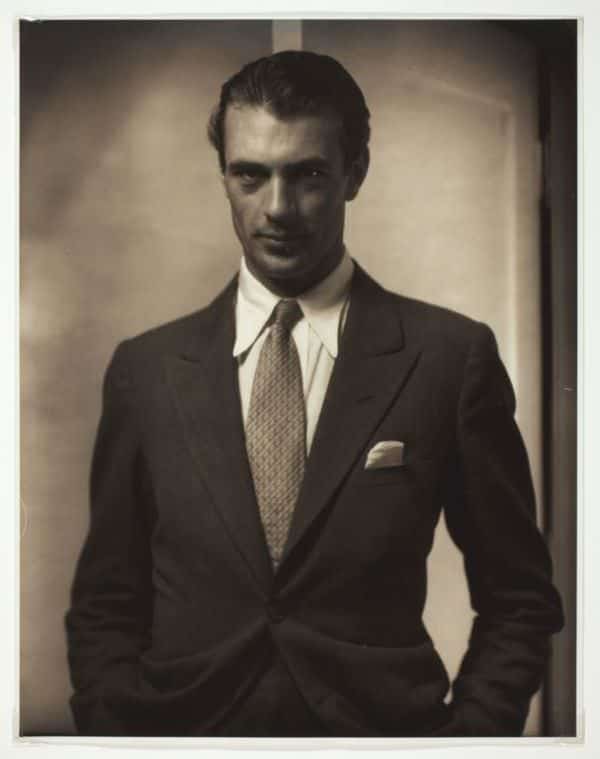
I find this ensemble very interesting because it features a large shirt collar with narrow points and relatively small, peaked lapels. Not the positioning of the buttonhole – I can’t think of any company or tailor that cuts a lapel like this anymore.

Last but not least another color photograph of Cooper wearing a light sand colores 3-roll-2 suit with inward facing pleats, three cuff buttons, striped shirt and patterned tie and pocket square.
Conclusion
Gary Cooper was the type of gentleman that men want to be and women want to be with. He was the epitome of grace and style and came by it naturally and seemingly effortlessly. There aren’t many men like Gary Cooper but he is proof that men such as him can exist. And, in my opinion, it’s something we can all strive to be. Hard working, devoted, passionate and caring.
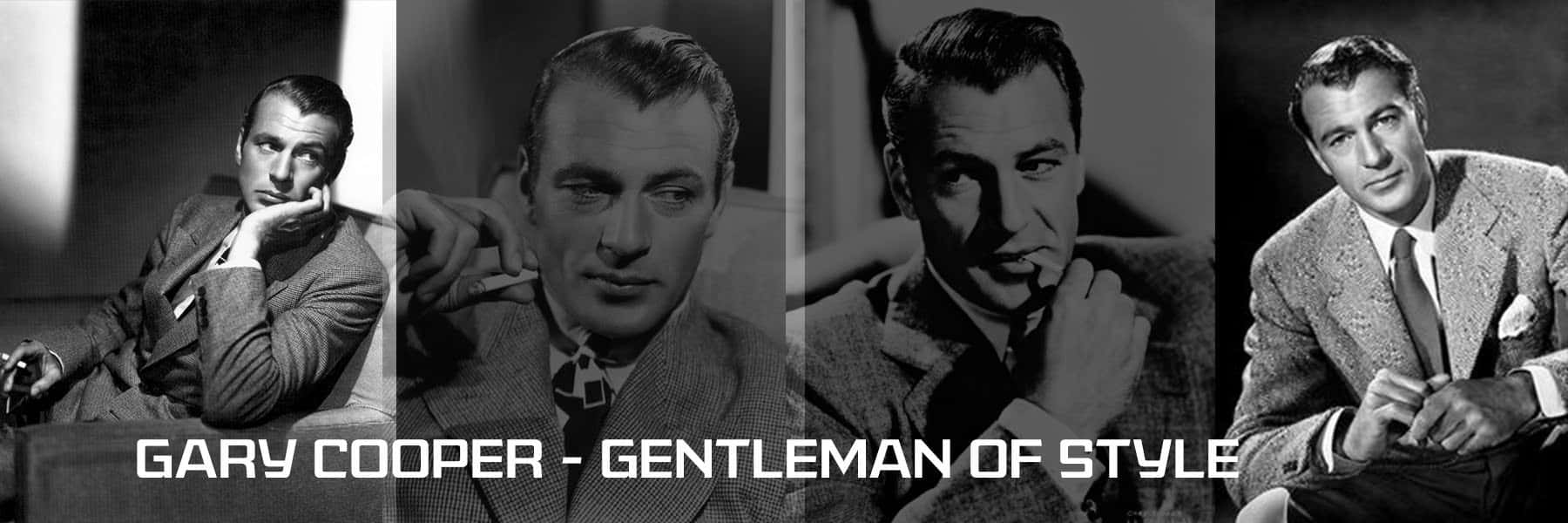






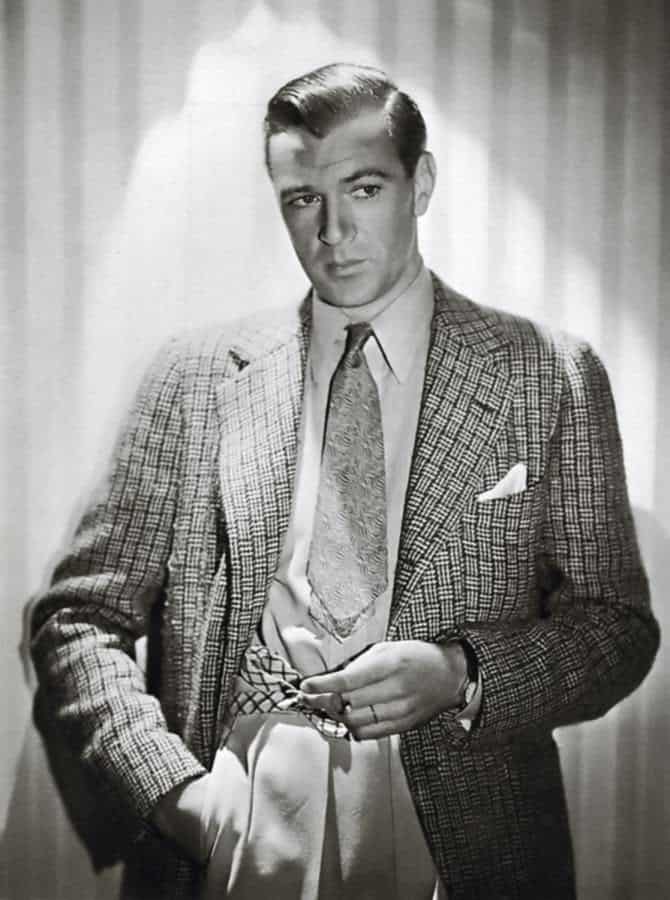

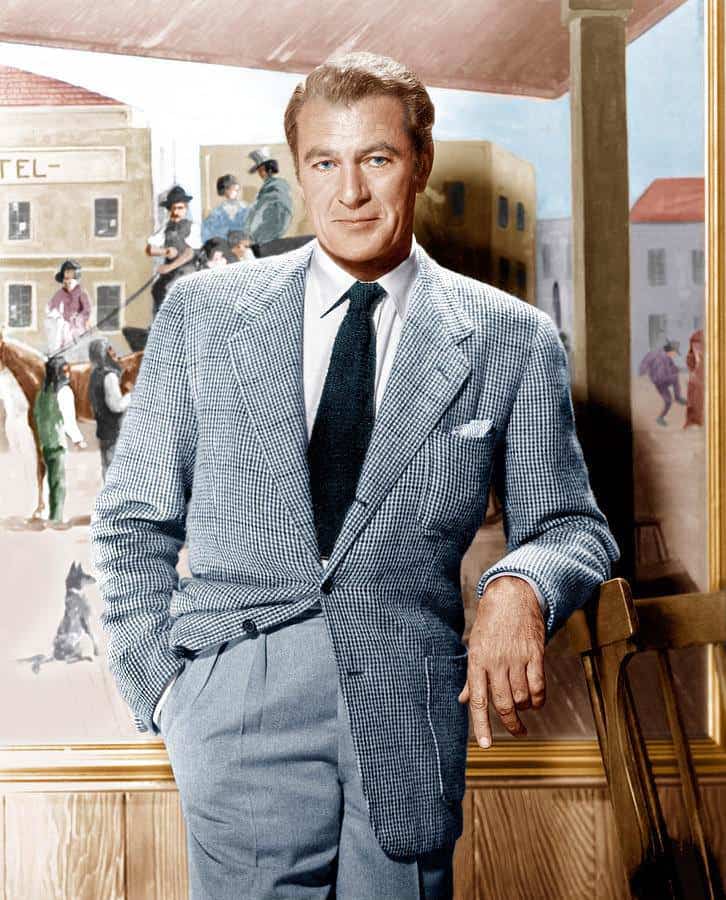
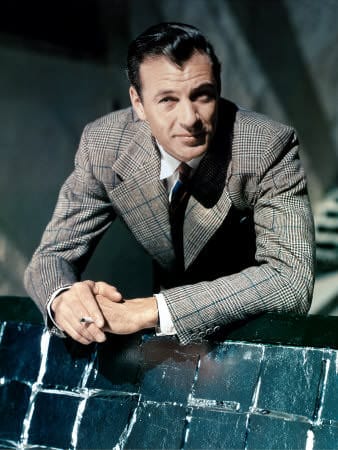

Spot-on characterization of one of Hollywood’s Golden Era male actors. James Stewart, Fred Astaire and others are also well deserving. Even the gifted Cole Porter felt compelled to include him in song. There was a sense of civility through even the depression. It may have been the War and entry into the fear of nuclear destruction that began a slow erosion toward the less gentlemanly attitudes of self and discourtesy here and there. But, as always a true Gentleman like e.e. cummings’ Roses you feel certain will only smile.
What a life Gary led … inspirational at this late hour as I reflect upon my life. Great post!
Some lovely illustrations of a stylish man. I wonder about a few of the captions in the first half of the article though. The picture described as Cooper with Audrey Hepburn in DB tuxedo looks as though he is wearing white tie tails to me, the picture next to it looks like a very nice Prince of Wales or Glen Check suit (rather than tweed jacket as described) and the illustration further down where he is wearing a peK lapel suit with odd waistcoat seems to show a soft woollen one(such as people still wear with morning coats regularly) rather than pique, as described.
Otherwise keep up the good work.
Sorry about that, our picture editor didn’t pay attention, and I overlooked it too. All is now corrected.
Great article on an inspirational man.